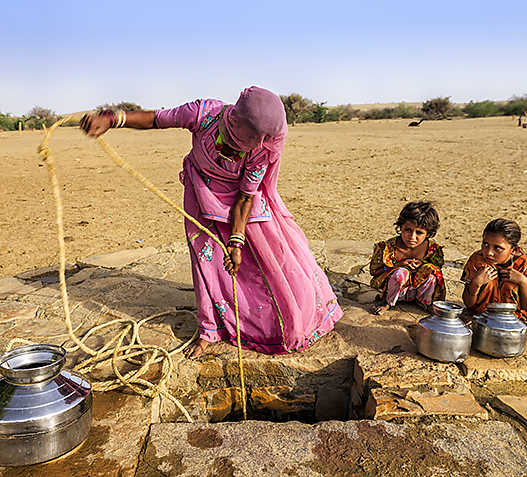HYDRO-SOCIAL APPROACH FOR WATER MANAGEMENT
HYDRO-SOCIAL APPROACH FOR WATER MANAGEMENT

FRESH WATER
- Water is one of the most basic, one of the most used, one of the most exploited and perhaps equal in importance to the other natural resources essential for the survival of life.
- Three-fourths of the Earth’s surface is covered with water. Hence known as the ‘water planet’
- Out of this, the oceans cover about two-thirds surface, thus unfit human consumption
- Only around 2.7% is available for human use out of which the maximum is covered under ice sheets and glaciers, thus inaccessible
- It comes down to just 1% of the water that can be considered to be fit for human use
- The Global Water System Project, which was launched in 2003 as a joint initiative of the Earth System Science Partnership (ESSP) and Global Environmental Change (GEC) programme, epitomises global concern about the human-induced transformation of fresh water and its impact on the earth system and society
- The fact is that freshwater resources are under stress, the principal driver being human activities in their various forms
FRESH WATER VALUATION
- In its fourth assessment report in 2007, the Intergovernmental Panel on Climate Change (IPCC) highlighted the link between societal vulnerability and modifications of water systems
- It is globally estimated that the gap between demand for and supply of fresh water may reach up to 40% by 2030 if present practices continue.
- The formation of the 2030 Water Resource Group in 2008, at the instance of the World Economic Forum, and the World Bank’s promotion of the group’s activity since 2018, is in recognition of this problem and to help achieve the Sustainable Development Goal (SDG) on water availability and sanitation for all by 2030 (SDG 6).
- Designing a comprehensive mix of divergent views about water (along with ecological and environmental issues) held by stakeholder groups is necessary.
- In this context, a hydro-social cycle approach provides an appropriate framework. It repositions the natural hydrological cycle in a human-nature interactive structure and considers water and society as part of a historical and relational-dialectical process.
INTER-BASIN TRANSFER PROJECTS
- The anthropogenic factors directly influencing a freshwater system are the engineering of river channels, irrigation and other consumptive use of water, widespread land use/land cover change, change in an aquatic habitat, and point and non-point source pollution affecting water quality.
- The intra- and inter-basin transfer (IBT) of water is a major hydrological intervention to rectify the imbalance in water availability due to naturally prevailing unequal distribution of water resources within a given territory.
- The National River Linking Project of India is under construction. These projects, if executed, will create artificial water courses that are more than twice the length of the earth’s equator and will transfer 1,910 km3 of water annually.
- They will reengineer the hydrological system with considerable local, regional and global ramifications.
- Based on a multi-country case study analysis, the World Wildlife Fund/World Wide Fund for Nature (2009) has suggested a cautious approach and the necessity to adhere to sustainability principles set out by the World Commission on Dams while taking up IBT projects.
SOME OF THE KEY ASSUMPTIONS
- Recently, inter-basin transfer of water drew attention in India due to a provision made in Budget 2022 for the Ken Betwa river link project which is a part of the National River Linking project (mooted in 1970 and revived in 1999).
- This decision raises larger questions about hydrological assumptions and the use and the management of freshwater resources in the country. We shall ponder over some of them.
- First, the basic premise of IBT is to export water from the surplus basin to a deficit basin. However, there is contestation on the concept of the surplus and deficit basin itself as the exercise is substantially hydrological. Water demand within the donor basin by factoring present and future land use, especially cropping patterns, population growth, urbanisation, industrialisation, socio-economic development and environmental flow are hardly worked out. Besides this, rainfall in many surplus basins has been reported as declining. The status of the surplus basin may alter if these issues are considered.
- Second, there is concern about the present capacity utilisation of water resources created in the country. By 2016, India created an irrigation potential for 112 million hectares, but the gross irrigated area was 93 million hectares. There is a 19% gap, which is more in the case of canal irrigation. In 1950-51, canal irrigation used to contribute 40% of net irrigated area, but by 2014-15, the net irrigated area under canal irrigation came down to less than 24%. Ground water irrigation now covers 62.8% of net irrigated area. The average water use efficiency of irrigation projects in India is only 38% against 50%-60% in the case of developed countries.
WAY FORWARD
Looking into these issues may not be adequate to address all the problems. Nevertheless, these measures will help to reduce demand supply gap in many places, and the remaining areas of scarcity can be catered to using small-scale projects. The axiom that today’s water system is co-evolving and the challenges are mainly management and governance has been globally well accepted. Water projects are politically charged and manifest an interplay of social relations, social power, and technology.
It is important to include less predictable variables, revise binary ways of thinking of ‘either or’, and involve non-state actors in decision-making processes. A hybrid water management system is necessary, where (along with professionals and policy makers) the individual, a community and society have definite roles in the value chain. The challenge is not to be techno-centric but anthropogenic.

